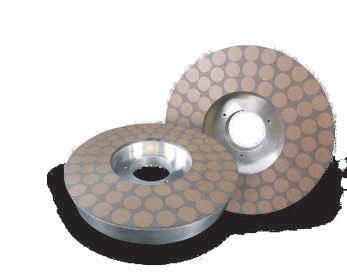
4 minute read
Flashback
The Hidden Costs of Poor Quality
(Editor’s note: The following article originally appeared in the Fall, 1998 issue of Springs. Coincidentally, that issue of the magazine was printed under the same theme as this edition, “Safety First.” Many will enjoy this look back because the article advocates that “If we could estimate every product’s total life cycle cost, then we would truly know the importance of process and product improvement.” That same value continues to hold true today.) Earlier this year, I served on the committee for a doctoral candidate, Lars Sörqvist, at the Royal Institute of Technology in Sweden. His thesis concerned poor quality costing. It examined how companies currently estimate poor quality costs and explored some new ideas about estimating actual costs. It also expanded upon the concept of total losses due to a company’s imperfect products and processes.
This theory, not completely new, relates to Genichi Taguchi’s earlier definition of “loss to society” caused by poor quality. When I first encountered this concept in the early 1980s, I found it hard to accept. At the same time, one of the early papers went so far as to suggest that if a television picture was too good, children watch too much TV, thereby resulting in a loss to society. But, as usual, Taguchi was ahead of his time, and now we’re beginning to realize the far-reaching implications of this line of thought.
Sörqvist carefully defines five levels of poor quality costs. The first level comprises the traditional poor quality costs of rework, warranties, scrap, inspection costs and other visible internal and external failure costs. Normally hidden expenses he classifies as level two costs. These include invoice errors, unnecessary paperwork and wasted meeting times incurred by management. But level two costs also include chronic, routine problems that are easy to ignore and frequent, unthinking corrections that aren’t captured by accounting systems.
In the third level, Sörqvist includes costs related to lost income. When marketplace goods and services fail to meet customers’ needs or wants, substantial losses may occur. Although it’s usually difficult to quantify them, these costs are real and often quite high. They may result in immediate loss of market share or goodwill as well as long-term market effects. Poor service in a hotel, for example, might not impact revenues from the customer’s current stay, but the customer’s refusal to return to that particular hotel could certainly impact future revenues.
Sörqvist’s fourth level of poor quality costs include losses incurred by customers. Such costs may or may not result in lost sales or market share and may not even result in warranty costs. Competitors may incur the same losses and customers may believe the costs are unavoidable.
These costs include early replacements (for example, light bulbs that last only a few thousand hours), incompatibilities with other equipment or software, items that are unnecessarily difficult to repair and other defects in design or workmanship for which customers end up paying.
But it’s the fifth level that stretches the usual definition of poor quality costs the farthest. These are the socio-economic costs, losses that affect a community due to inadequate processes or products of companies, organizations or governments. These
costs have become increasingly more obvious. They include products that can’t be easily recycled and are harmful to the environment; manufacturing wastes that poison the air, land and water; and products with harmful side effects.
Many of these costs are only visible years later. The worldwide costs of DDT, lead-based paints, asbestos, pesticides, certain pharmaceuticals and industrial products are hard to estimate. Short-term benefits from these products invariably obscure long-term hazards. A drug with a serious side effect can create costs to society far beyond its obvious damage to the individuals using it.
For instance, society often overreacts to the drug and creates new laws requiring lengthy testing procedures that affect manufacturers of similar products for years to come. In the process, many useful new medicines are delayed or prevented from reaching the market, thus causing unnecessary deaths and suffering.
Governments create many of society’s greatest losses. At local, state and federal levels, layers of needless work accumulate. Anyone who has responded to proposal requests from government agencies has glimpsed at the enormous waste potential built into their processes. Anyone who has waited in long tollbooth lines has experienced the elaborate systems designed to collect thousands of dollars while squandering millions in valuable time.
It would be instructive to extend total life cycle costs to include the fifth level. What if government agencies had to prove that the value of information they collected was greater than the costs of collecting it? What if tollbooths stopped operating every time the combined value of commuters’ waiting times exceeded the money being collected? If we could see an estimate of every appliance’s total life cycle costs (energy use, maintenance and recycling cost) we’d likely make quite different buying decisions.
Perhaps we’d greatly intensify our quality efforts if we had accurate estimates of all five levels of poor quality costs and understood the true effect of improving our processes and products. n
A. Blanton Godfrey is dean and Joseph D. Moore Distinguished University Professor at North Carolina State University’s College of Textiles. Prior to his current assignment, he was chairman and CEO of Juran Institute Inc. Email him at agodfrey@qualitydigest.com. This article was originally reprinted with permission of Juran Institute Inc. and Quality Digest.
FIVES, A LEADER IN SPRING GRINDING ABRASIVE TECHNOLOGY


— Cutting Tools | Abrasives E: cuttingtools.abrasives@ vesgroup.com - Concord Twp., Ohio - South Beloit, Illinois - USA
Fives_.5 p. _hor_.25 bleed_.25_margin_2019 Summer.indd 1 4/23/2019 4:55:59 PM










